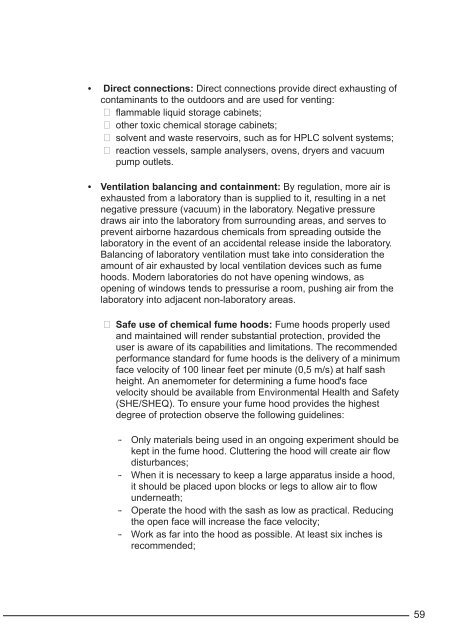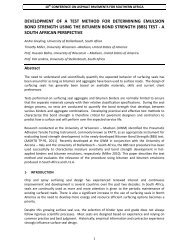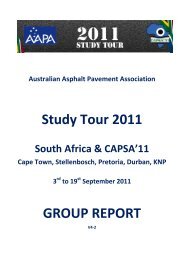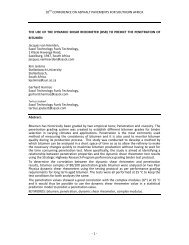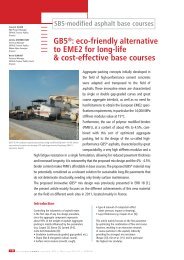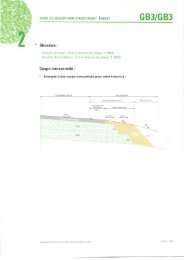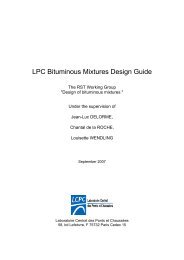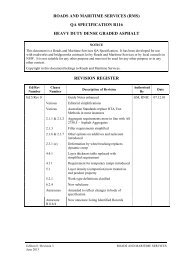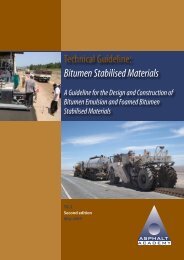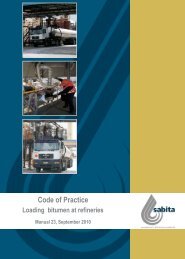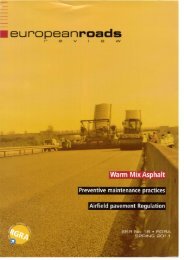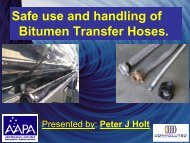Guide to the safe handling of solvents in a bituminous ... - Aapaq.org
Guide to the safe handling of solvents in a bituminous ... - Aapaq.org
Guide to the safe handling of solvents in a bituminous ... - Aapaq.org
- No tags were found...
You also want an ePaper? Increase the reach of your titles
YUMPU automatically turns print PDFs into web optimized ePapers that Google loves.
• Direct connections: Direct connections provide direct exhaust<strong>in</strong>g <strong>of</strong>contam<strong>in</strong>ants <strong>to</strong> <strong>the</strong> outdoors and are used for vent<strong>in</strong>g: flammable liquid s<strong>to</strong>rage cab<strong>in</strong>ets; o<strong>the</strong>r <strong>to</strong>xic chemical s<strong>to</strong>rage cab<strong>in</strong>ets; solvent and waste reservoirs, such as for HPLC solvent systems; reaction vessels, sample analysers, ovens, dryers and vacuumpump outlets.• Ventilation balanc<strong>in</strong>g and conta<strong>in</strong>ment: By regulation, more air isexhausted from a labora<strong>to</strong>ry than is supplied <strong>to</strong> it, result<strong>in</strong>g <strong>in</strong> a netnegative pressure (vacuum) <strong>in</strong> <strong>the</strong> labora<strong>to</strong>ry. Negative pressuredraws air <strong>in</strong><strong>to</strong> <strong>the</strong> labora<strong>to</strong>ry from surround<strong>in</strong>g areas, and serves <strong>to</strong>prevent airborne hazardous chemicals from spread<strong>in</strong>g outside <strong>the</strong>labora<strong>to</strong>ry <strong>in</strong> <strong>the</strong> event <strong>of</strong> an accidental release <strong>in</strong>side <strong>the</strong> labora<strong>to</strong>ry.Balanc<strong>in</strong>g <strong>of</strong> labora<strong>to</strong>ry ventilation must take <strong>in</strong><strong>to</strong> consideration <strong>the</strong>amount <strong>of</strong> air exhausted by local ventilation devices such as fumehoods. Modern labora<strong>to</strong>ries do not have open<strong>in</strong>g w<strong>in</strong>dows, asopen<strong>in</strong>g <strong>of</strong> w<strong>in</strong>dows tends <strong>to</strong> pressurise a room, push<strong>in</strong>g air from <strong>the</strong>labora<strong>to</strong>ry <strong>in</strong><strong>to</strong> adjacent non-labora<strong>to</strong>ry areas. Safe use <strong>of</strong> chemical fume hoods: Fume hoods properly usedand ma<strong>in</strong>ta<strong>in</strong>ed will render substantial protection, provided <strong>the</strong>user is aware <strong>of</strong> its capabilities and limitations. The recommendedperformance standard for fume hoods is <strong>the</strong> delivery <strong>of</strong> a m<strong>in</strong>imumface velocity <strong>of</strong> 100 l<strong>in</strong>ear feet per m<strong>in</strong>ute (0,5 m/s) at half sashheight. An anemometer for determ<strong>in</strong><strong>in</strong>g a fume hood's facevelocity should be available from Environmental Health and Safety(SHE/SHEQ). To ensure your fume hood provides <strong>the</strong> highestdegree <strong>of</strong> protection observe <strong>the</strong> follow<strong>in</strong>g guidel<strong>in</strong>es:¨¨¨¨Only materials be<strong>in</strong>g used <strong>in</strong> an ongo<strong>in</strong>g experiment should bekept <strong>in</strong> <strong>the</strong> fume hood. Clutter<strong>in</strong>g <strong>the</strong> hood will create air flowdisturbances;When it is necessary <strong>to</strong> keep a large apparatus <strong>in</strong>side a hood,it should be placed upon blocks or legs <strong>to</strong> allow air <strong>to</strong> flowunderneath;Operate <strong>the</strong> hood with <strong>the</strong> sash as low as practical. Reduc<strong>in</strong>g<strong>the</strong> open face will <strong>in</strong>crease <strong>the</strong> face velocity;Work as far <strong>in</strong><strong>to</strong> <strong>the</strong> hood as possible. At least six <strong>in</strong>ches isrecommended;59


